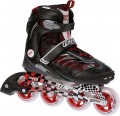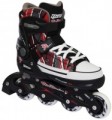Size
—
Fixed size. Boots of the simplest design, having one size and not allowing for adjustment in length. In addition to the obvious disadvantage of the impossibility of adjusting to size, this design also has an advantage - it is considered more durable and reliable than an adjustable one, and if selected correctly, it sits “firmer” on the foot, which makes such boots more suitable for performing various tricks. In general, rollers with a fixed size are suitable either for an adult user whose leg is no longer growing, or for a child, if we are talking about a pair for one season.
—
Adjustable size. Boots that allow you to adjust the size within a certain range - usually within 3 - 5 sizes, for example 36 - 39 or 28 - 32. The advantages of this option are obvious: it allows you to optimally adjust the boot to your foot size, one pair of rollers can be used in turn by different people, and for rollers bought for a growing child, the adjustable size is simply a salvation: without this, the rollers would have to be changed every year. On the other hand, adjustment complicates the design of the boot and reduces its strength, so this design is not widespread in professional models (“aggressive”, running, etc.).
The size itself is given according to standard shoe sizes. At the same time, the listing of sizes - for example, “
39,
40..., 41 ” - means that the rollers are available in several modifications with a fixed size; and a hyphenated record like “39 – 41” corresponds to one shoe with an adjustable size.
Note that formal compliance with the foot size does not necessarily mean that the rollers will suit a particular user. Firstly, human legs have individual shapes, and a model that is normal in length may, for example, turn out to be cramped in the instep. Secondly, some manufacturers can be quite liberal with sizes, especially when it comes to budget models. Therefore, when choosing, it is recommended not to rely on the stated figures, but to check the comfort of the boot “live” (or at least clarify how the stated dimensions correspond to the actual ones), especially for children’s skates.
Currently the following roller sizes are available on the market: 25, 26, 27, 28, 29, 30, 31, 32, 33, 34, 35, 36, 37, 38, 39, 40, 41, 42, 43, 44, 45, 46, 47.Wheel stiffness
Stiffness of wheels supplied with roller skates.
The higher the number given in this parameter, the harder materials are used in the construction of the wheels and the stiffer they are. Stiffer wheels better roll on different surfaces, it is easier to accelerate on them, they allow you to more accurately feel the surface under your feet and do not wear out as quickly as soft ones. On the other hand, these wheels have less grip, are more prone to vibrations and bumps, and require extra care when cornering. Therefore, wheels with high stiffness (
83A and above) are typical mainly for professional models, and soft options are recommended for beginner skaters.
Note that most modern roller skates allow the replacement of wheels; this procedure is mandatory from time to time since the wheels tend to wear out. However, if necessary, you can also change a kit that is quite suitable for riding — for a harder one, or vice versa, a softer one.
At the same time, an experienced person buying new roller skates can pre-select the desired wheel stiffness among those on the market:
78A,
80A,
81A,
82A,
83A,
84A,
85A,
86A,
88A,
90A..., 94AWheel size
The diameter of the wheels supplied with roller skates.
This parameter is usually selected by the manufacturer based on the style of riding for which the rollers are designed (see above). The general rule is this: the
larger the diameter, the more “high-speed” the wheels are considered and the less sensitive they are when hitting bumps. Wheels with a diameter of about 76 – 82 mm are considered universal, these are the sizes that are found in most fitness roller skates and stunt models (see "Riding style"). In running equipment, this size can be noticeably larger — this is done to ensure a fast and smooth ride. But on the "aggressive" models, the wheels, on the contrary, are small — with this driving style, it is critical to feel all the bumps under the rollers.
Bearing
Class of bearings installed in roller skates.
There are several standards by which this parameter can be designated. The most popular is ABEC (Annular Bearing Engineering Committee), and the ILQ (InLine Qualified) designation is also common. In both cases, the bearing class is expressed by a number after the abbreviation:
ABEC 1,
ABEC 3,
ABEC 5,
ABEC 7,
ABEC 9 or
ILQ 5,
ILQ 7,
ILQ 9. The higher this figure, the higher the accuracy with which the bearing is made, and the higher the quality (and, accordingly, the more expensive it is). The meaning of specific numbers in both standards is the same. So, class 1 and 3 bearings are typical mainly for entry-level children models, and they are used not so much to reduce cost, but because it simply does not make sense to install better parts in such rollers. Class 5 is considered quite sufficient for mid-level fitness roller skates and inexpensive stunt models (see "Riding style"), and higher values are typical mainly for professional equipment.
We note that the class of bearings is not related to their speed characteristics — it is only about the overall build quality. But this parameter noticeably affects the service life: precise fitting of
...parts helps to reduce their wear and increase the durability of bearings.Frame material
The material from which the frame of roller skates is made. The frame is the structural element to which the wheels are directly attached.
The general trends among frame materials are as follows. Plastic structures dampen vibrations and shocks better; metal due to rigidity, on the one hand, creates some discomfort, but they are more elastic and better suited for pushes and jumps. The use of metal for the frame is considered an indicator of a fairly high class of rollers, although the real need for such material is far from always present.
However, each type of material has its specific features:
— Plastic. Inexpensive material, typical mainly for simple skates designed for recreational riding. It is generally strong enough for this application; however, more difficult tasks can cause problems — not only because of the possible breakage of the plastic frame but also because of the low elasticity, poorly suited for jumping.
— Carbon — a composite material that combines plastic with carbon fibre. This option is considered extremely advanced because the frames are no less durable than metal ones, while they compare favourably with elasticity and the absence of permanent deformations even under heavy loads. The main disadvantage of this option is the high cost.
— Steel. The main advantage of steel is its high strength, besides, it is somewhat cheaper than alloys based on aluminium and magnesium. At the same time, this mat...erial is heavy and relatively easily deformed under load. Therefore, in modern roller skates, such frames are practically not found.
— Aluminium. In this case, usually, we are not talking about pure aluminium, but about various alloys based on it (excluding duralumin — see below about it). In general, this material is considered more advanced than plastic — in particular, with a fairly low weight, it has good strength. And the aluminium frames look quite attractive. At the same time, there are many varieties of this material, differing in characteristics and price. The most affordable ones tend to bend under fairly small loads, and durable and resistant, and usually, are not cheap.
— Duraluminium. In this case, a high-quality variety of aluminium alloys with copper and some other additives is meant. Duralumin combines low weight with excellent strength characteristics, and also does not deform even under fairly heavy loads; on the other hand, it is quite expensive. For these reasons, the main area of application for this material is high-end inline skates, primarily for cross-country use.
— Magnesium alloy. Magnesium-based alloys are for the most part very similar to the duralumin described above: they have high strength specs (although this indicator can vary significantly depending on the composition) and low weight. However, they are not cheap and, therefore, are installed mainly in top-level models.

